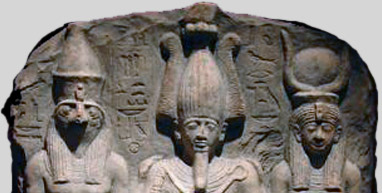

In the Greek cities such as Alexandria, by the time the Romans took over, the Greek and Egyptian gods had merged in a bizarre syncretistic identification, for example, the Greek God Pan invoked but coupled with a stele of the Egyptian god Min. Temples were “multi‑service,” dedicated both to the Greek and Egyptian gods, but the Olympian deities steadily were shedding their separate identity even as their names survived in written documents. Cleopatra spoke not just Greek but Egyptian, identified herself strongly as Isis, and killed herself with the "sacred snake whose image was worn on the crown of Lower Egypt...its bite gave her immortality and a place among the gods," as historian Harold Idris Bell describes in his comprehensive book, Cults and Creeds in Graeco-Roman Egypt (1953).
Still, while Greeks strongly assimilated Egyptian beliefs and perpetuated the old religion, they did so with a uniquely Greek perspective. They applied their philosophy to the Egyptian religion, giving it, in Bell's words, an “order and coherence” it had never had before. Reading Plutarch's version of the Isis‑Osiris myth is a vastly different experience.
Still, no substantial Greek temples were constructed outside of Alexandria and the two Greek‑established cities of Naucratis and Ptolemais. Instead, temples in other parts of Egypt continued to be designed and constructed in the old architectural schemes, with the wisdom of the elders inscribed on their walls remaining as passed down over the eons. Greek writing did not replace hieroglyphics in religious texts, and when texts did reference the Greek names of the old gods, Lewis suggested the villagers were merely “namedropping, using the Greek appellatives of the privileged classes for their local native Gods.” The old gods still reigned thus in much of the country, though a few subtle changes were emerging. One was an increasing tendency to support one god above the others—to single out one deity such as Isis or Serapis, resulting in the division of the religion into a series of cults. Also on the rise was the revival and spread of animal worship, which may have been a conscious return by priests to an early form of the religion.
Hellenizing of Egyptian religion did not, however, succeed in ingratiating the trespassers with the indigenous population. That Ptolemy IX felt it necessary to withdraw taxation for temple lands, dole out state monies for the burial of sacred bulls, and grant asylum for the priesthood suggests an effort to placate resentment from the priesthood in the late Ptolemaic period. For some 19 years during the rule of Ptolemy IV, the priesthood even had placed a native Egyptian pharaoh on the throne, ruling Upper Egypt. In other words, the old religion, while it had undergone some changes. remained a powerful rallying force in periods of crisis. Egyptians still believed they could achieve a return to the old, better ways not through transformation, but through invoking their old gods.
Glorious Colony of a Divine Empire
To the Romans, their right to rule other peoples was even more than divinely sanctioned; they were the chosen ones of the Gods. In the Aeneid, which traced the Romans back to descendents of Troy, Virgil writes:
"Roman, remember by your strength to rule
Earth's peoples—for your arts are to be these:
To pacify, to impose the rule of law,
To spare the conquered, battle down the proud."
(Fitzgerald, 1983: bk VI, l. 854‑856)
And:
"Caesar Augustus, son of the deified
Who shall bring once again an Age of Gold
To Latium, to the land where Saturn reigned...
At that man's coming even now the realms
Of Caspia and Maeotia tremble, warned
By oracles, and the seven mouths of Nile
Go dark with fear."
(bk VI, l. 792‑794, l. 800‑804)
_____________________________________________
These words are not ones associated with cross‑cultural tolerance.






